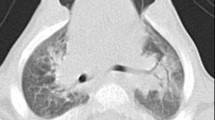Abstract
Childhood interstitial lung disease (chILD) is a heterogeneous group of uncommon, mostly chronic pediatric pulmonary disorders characterized by impaired gas exchange and diffuse abnormalities on imaging. A subset of these diseases occurs more frequently in infants and young children than in older children and teenagers. Some of these disorders occur in certain clinical scenarios and/or have typical imaging features that can help the radiologist recognize when to suggest a possible diagnosis and potentially spare a child a lung biopsy. We review the clinical, histopathological and computed tomography features of chILD more prevalent in infancy, including diffuse developmental disorders, growth abnormalities, specific conditions of undefined etiology, and surfactant dysfunction mutations and related disorders, to familiarize the pediatric radiologist with this group of disorders.















Similar content being viewed by others
References
Deutsch GH, Young LR, Deterding RR et al (2007) Diffuse lung disease in young children: application of a novel classification scheme. Am J Respir Crit Care Med 176:1120–1128
Fan LL, Deterding RR, Langston C (2004) Pediatric interstitial lung disease revisited. Pediatr Pulmonol 38:369–378
Langston C, Dishop MK (2009) Diffuse lung disease in infancy: a proposed classification applied to 259 diagnostic biopsies. Pediatr Dev Pathol 12:421–437
Fan LL, Dishop MK, Galambos C et al (2015) Diffuse lung disease in biopsied children 2 to 18 years of age. Application of the chILD classification scheme. Ann Am Thorac Soc 12:1498–1505
Bush A, Cunningham S, de Blic J et al (2015) European protocols for the diagnosis and initial treatment of interstitial lung disease in children. Thorax 70:1078–1084
Griese M, Haug M, Brasch F et al (2009) Incidence and classification of pediatric diffuse parenchymal lung diseases in Germany. Orphanet J Rare Dis 4:26
Kurland G, Deterding RR, Hagood JS et al (2013) An official American Thoracic Society clinical practice guideline: classification, evaluation, and management of childhood interstitial lung disease in infancy. Am J Respir Crit Care Med 188:376–394
Semple TR, Ashworth MT, Owens CM (2017) Interstitial lung disease in children made easierwell, almost. Radiographics 37:1679–1703
Guillerman RP, Brody AS (2011) Contemporary perspectives on pediatric diffuse lung disease. Radiol Clin N Am 49:847–868
Ahmed S, Ackerman V, Faught P, Langston C (2008) Profound hypoxemia and pulmonary hypertension in a 7-month-old infant: late presentation of alveolar capillary dysplasia. Pediatr Crit Care Med 9:e43–e46
Stankiewicz P, Sen P, Bhatt SS et al (2009) Genomic and genic deletions of the FOX gene cluster on 16q24.1 and inactivating mutations of FOXF1 cause alveolar capillary dysplasia and other malformations. Am J Hum Genet 84:780–791
Bishop NB, Stankiewicz P, Steinhorn RH (2011) Alveolar capillary dysplasia. Am J Respir Crit Care Med 184:172–179
Dishop MK (2010) Diagnostic pathology of diffuse lung disease in children. Pediatr Allergy Immunol Pulmonol 23:69–85
Guillerman RP (2010) Imaging of childhood interstitial lung disease. Pediatr Allergy Immunol Pulmonol 23:43–68
Lee EY (2013) Interstitial lung disease in infants: new classification system, imaging technique, clinical presentation and imaging findings. Pediatr Radiol 43:3–13
Shelmerdine SC, Semple T, Wallis C et al (2017) Filamin a (FLNA) mutation-a newcomer to the childhood interstitial lung disease (ChILD) classification. Pediatr Pulmonol 52:1306–1315
Canakis AM, Cutz E, Manson D, O’Brodovich H (2002) Pulmonary interstitial glycogenosis: a new variant of neonatal interstitial lung disease. Am J Respir Crit Care Med 165:1557–1565
Deutsch GH, Young LR (2009) Histologic resolution of pulmonary interstitial glycogenosis. Pediatr Dev Pathol 12:475–480
Lanfranchi M, Allbery SM, Wheelock L, Perry D (2010) Pulmonary interstitial glycogenosis. Pediatr Radiol 40:361–365
Weinman JP, White CJ, Liptzin DR et al (2018) High-resolution CT findings of pulmonary interstitial glycogenosis. Pediatr Radiol 48:1066–1072
Deterding RR, Pye C, Fan LL, Langston C (2005) Persistent tachypnea of infancy is associated with neuroendocrine cell hyperplasia. Pediatr Pulmonol 40:157–165
Kerby GS, Wagner BD, Popler J et al (2013) Abnormal infant pulmonary function in young children with neuroendocrine cell hyperplasia of infancy. Pediatr Pulmonol 48:1008–1015
Brody AS, Guillerman RP, Hay TC et al (2010) Neuroendocrine cell hyperplasia of infancy: diagnosis with high-resolution CT. AJR Am J Roentgenol 194:238–244
LeMoine BD, Browne LP, Liptzin DR et al (2019) High-resolution computed tomography findings of thyroid transcription factor 1 deficiency (NKX2-1 mutations). Pediatr Radiol 49:869–875
Mechri M, Epaud R, Emond S et al (2010) Surfactant protein C gene (SFTPC) mutation-associated lung disease: high-resolution computed tomography (HRCT) findings and its relation to histological analysis. Pediatr Pulmonol 45:1021–1029
Doan ML, Guillerman RP, Dishop MK et al (2008) Clinical, radiological and pathological features of ABCA3 mutations in children. Thorax 63:366–373
Johkoh T, Itoh H, Muller NL et al (1999) Crazy-paving appearance at thin-section CT: spectrum of disease and pathologic findings. Radiology 211:155–160
Author information
Authors and Affiliations
Corresponding author
Ethics declarations
Conflicts of interest
None
Additional information
Publisher’s note
Springer Nature remains neutral with regard to jurisdictional claims in published maps and institutional affiliations.
Rights and permissions
About this article
Cite this article
Schapiro, A.H., Baker, M.L., Rattan, M.S. et al. Childhood interstitial lung disease more prevalent in infancy: a practical review. Pediatr Radiol 52, 2267–2277 (2022). https://doi.org/10.1007/s00247-022-05375-x
Received:
Revised:
Accepted:
Published:
Issue Date:
DOI: https://doi.org/10.1007/s00247-022-05375-x




